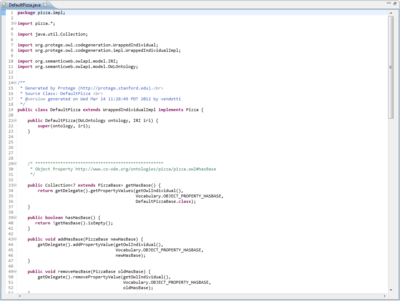Protege 4.2 Beta Release Notes
From Protege Wiki
Revision as of 16:35, July 12, 2012 by JenniferVendetti (talk | contribs) (added release notes for build 278)
Protege 4.2 Beta
We are pleased to announce Protege 4.2 beta! The main thrust of the 4.2 series will be the roll out of several new plug-ins, including an ontology difference tool, enhanced explanation support, client-server capabilities, support for code generation, and a database back-end. Please contact us via the Protege 4 mailing list with questions, feedback, and bug reports.
Download Protege 4.2 beta from the main Protege website (new users, please register first).
Contents
Release Notes
The contents of the release notes section describe changes relative to Protege 4.1 and Protege 4.2 alpha.
Build 278 -- July 12, 2012
- Fixed a bug that caused the Usage view to fail with a NullPointerException if it was displayed before an entity of the appropriate type was selected. For example, if a user opened an ontology and selected the class usage view before selecting a class, the view would fail. The view could then only be restored by resetting the UI or restarting Protege.
- The rename multiple entities tool (Refactor | Rename multiple entities...) no longer has problems renaming URIs that include characters with special meanings for a regular expression search.
- Interrupting a reasoner now works properly with two provisos. First, some reasoners will not respond to an interrupt. This is a reasoner problem and we can't fix that. Second, after the interrupt, Protege will continue to use the reasoner. This will be dealt with in the next version of Protege.
- Added a Stop reasoner menu item to allow users to stop a reasoner (Reasoner | Stop reasoner). Previously, the best method of stopping a reasoner was to select a different default reasoner type.
- Changed the default configuration of the Individuals tab in response to some comments on the p4-feedback mailing list. The previous configuration could be confusing because all the views of the collection of individuals were filtered by the selected class.
- Centralized and improved the handling of vacuous inferred results. Previously, several inferred views would be cluttered with a large number of trivial results. Now this clutter has been somewhat trimmed and the trimming is applied consistently across the user interface.
- Fixed a problem with new entity preferences where it was possible for the generated fragment to use an auto-generated ID, but the label provided by the user was not used.
- Fixed a bug where the Object/Data restriction creator sometimes failed to allow valid input.
- Fixed the Add to ontology button in the DL Query tab.
Build 276 -- May 21, 2012
- Fixed a bug in the OWLViz visualization plug-in that caused NumberFormatExceptions.
Build 274 -- May 18, 2012
- Fixed several bugs in the OntoGraf visualization plug-in that caused ClassCastExceptions.
Build 273 -- May 11, 2012
- It is now possible for users to download and/or update plug-ins even when the Protege distribution is read-only. If the auto update mechanism can't write to Protege's plugin subdirectory, it falls back to writing to a user directory. This mainly effects Windows users who install to the Program Files directory, but it's also important for Linux administrators who create a shared Protege installation for multiple users.
- Modified the annotation editor so that it remembers which tab was last selected.
- Deprecated entities now get rendered with strikethroughs.
- The button for editing annotations on axioms now gets highlighted in orange when an axiom has annotations, thus making it easier to notice.
- Fixed a bug in the ontology repository mechanism that caused some valid XML catalog files to be rejected.
- Fixed a bug that caused the save operation to add extra axioms from imported to importing ontologies.
- Fixed a bug where automatically generated IDs would get incremented on each keystroke when users created new entities.
- Fixed a long-standing bug where Protege would freeze while trying to generate a new ID for an entity.
- Fixed a bug in the Bookmarks plug-in that caused it to fail immediately upon being activated in the user interface. The Bookmarks plug-in is available for download via the auto update mechanism (File | Check for plugins... | Downloads | Bookmark View).
- Fixed a bug in the OWLDoc plug-in where clicking on the Show Source button caused a NullPointerException. The OWLDoc plug-in is available for download via the auto update mechanism (File | Check for plugins... | Downloads | OWLDoc).
Build 269 -- March 21, 2012
- Introduced a new explanation plug-in in addition to the existing basic explanation plug-in provided in previous releases. The new explanation plug-in, referred to as "Justification Based Explanation", will generate multiple explanations for a single inference, will sort the explanation to be more readable, and can generate laconic explanations (laconic justifications). The plug-in can also generate explanations for inconsistent ontologies (previous releases only included an ad-hoc tool, which in some cases was unable to find any explanation for a problem).
- Fixed a bug that could cause Protege to crash during start-up.
Build 265 -- March 14, 2012
- Improved the user interface for the Active Ontology tab so that the ontology name and version are much more prominent, thereby encouraging users to set versions when appropriate.
- Launching the Protege application now opens an empty ontology instead of a welcome screen. This is part of a broader effort to align Protege's behavior with common document editing tools, e.g., opening Microsoft Word presents users with a blank document.
- Added support for Java code generation. Available from Tools | Generate Protege-OWL Java Code.
- Protege no longer requires administrative privileges to run on Windows machines. Please note the exception that downloading new plug-ins will still require Protege to be run in administrative mode.
